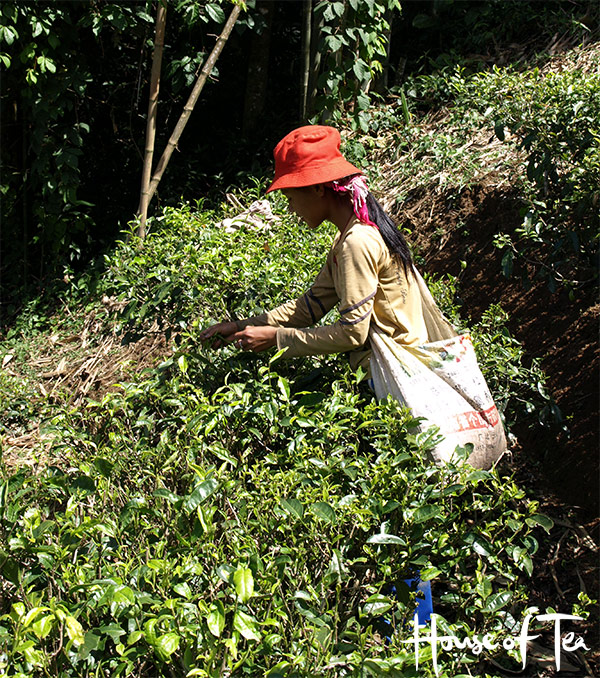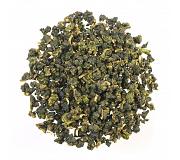Green tea

GREEN TEA – FROM TEA PLANT TO CUP
Green tea is tea from the tea plant Camellia sinensis that has been heated after harvest to stop oxidation and preserve the green colour of the leaves. Green tea has a long history above all in China and Japan, but is still less familiar to many people in Europe.
With us you will find a wide range of green teas – from exclusively handpicked Chinese and Japanese teas to good value everyday teas. See our full range of green teas »
WHAT DEFINES GREEN TEA?
The crucial difference between green tea and darker teas is oxidation. Green tea is not oxidised. The tea is heated as soon as possible after picking, which stops oxidation and keeps the leaves green.
In tea circles oxidation is sometimes mistakenly called "fermentation". This has led to the misconception that tea is actually fermented. For green tea this is not the case – it is about the leaves reacting with air (oxidising), not being fermented by microorganisms.
To stop oxidation the tea is heated in different ways:
- Dry roasting – common in China, often giving a roasted or nutty note.
- Steaming – common in Japan, often giving a green, full-bodied and more "grassy" character.
- Hot air or oven-like methods – used in certain regions and giving other nuances.
WHY DO GREEN TEAS TASTE SO DIFFERENT?
The differences between various green teas are large – roughly like the differences between different wines. It is not enough to "take a tea plant and heat the leaves" to get a good tea. Several factors influence the flavour:
- Cultivar – which variety of tea plant is used.
- Age of the tea bushes – older bushes often give a different character than younger ones.
- Plucking standard – which leaves are picked (for example bud plus two leaves) and when during the season.
- Processing – how quickly the tea is heated, how carefully roasting or steaming is carried out, drying, sorting etc.
Producing green tea is a craft. Every step in the process leaves its mark on flavour, aroma and price.
HANDMADE TEAS AND CRAFT
No machine can fully replace an experienced tea picker who knows exactly which leaves to pick. Handpicked teas are generally more carefully sorted and more consistent in quality than machine-picked teas. Most often the bud is picked with the two following leaves.
Heating is still carried out by hand in many Chinese regions. Over-roasting or heating too hard can create imbalance in the flavour, while the right handling brings out sweetness, fullness or freshness depending on the style of tea.
GRADING AND PRICE
Teas are often graded according to craftsmanship and raw material. A tea with a higher grade will usually have a more well-balanced flavour, while simpler grades can have a more straightforward character. But since grading systems differ between producers, grading is not a reliable measure of quality on its own.
The price is affected by factors such as:
- grading and plucking standard
- region and growing conditions
- cultivar
- whether the tea is authentic from a classic region or produced in another area
ORGANIC GREEN TEA
Organic tea production is not only about growing methods but also about certification, inspections and administration. Many small producers in practice grow in a way that corresponds to organic production, above all because chemical residues can be noticed in the final taste, but still choose not to certify because the cost is high.
Larger producers with more large-scale, simpler quality often find it easier to bear the cost of certification and can use the label as a way to make simpler teas more marketable. An organic certification therefore means that the tea is grown according to the rules for organic production – not automatically that it is higher quality in terms of flavour.
The range of organic green tea is growing and in the long term the cost of certification may decrease, which makes the price level more reasonable.
ALTITUDE AND GROWING CONDITIONS
Tea bushes at high altitude grow more slowly. This often gives a more concentrated flavour and can reduce insect attacks. Many exclusive teas are therefore grown at higher elevations.
Not all high-quality green tea comes from high altitudes. In Japan tea is generally grown at relatively low elevations, but with other factors – such as cultivar, shading and processing – giving character and complexity. Exclusive green tea is also grown on a smaller scale in other countries, for example Korea and Taiwan, but with significantly smaller volumes than in China and Japan.
CHINA AND JAPAN
The largest production of high-quality green tea takes place in China and Japan. Tea culture arose in China and spread to Japan and later also to other countries, including Korea, around the 7th–8th century, where the traditions developed in different directions.
- China – very large variation between regions and styles. The focus is often more on the tea itself than on ceremony.
- Japan – has developed its own tea and matcha culture with distinct traditions and ceremonies. The flavour profile is often full-bodied, rich in umami and green.
Tea is also grown on a smaller scale in other countries, but when talking about green tea as a quality drink, China and Japan are the two central producers. Chinese and Japanese green tea often differ so much that they are better compared as "apples and pears" than as the same style.
GREEN TEA AND HEALTH
Tea is one of the most consumed beverages in the world and has been used for a long time, among other things within traditional Chinese culture. In recent decades many scientific studies have examined green tea and its constituents, for example polyphenols and caffeine, in relation to various health markers.
The results vary between different studies, but green tea is often mentioned in research as a part of an otherwise balanced lifestyle. We focus on offering green tea with high quality, clear origin and good flavour – those who wish to delve deeper can consult the medical literature and current review articles.
HOW TO BREW GREEN TEA
Green tea is generally brewed at a lower temperature than darker teas. If you brew too hot or too long you will easily get a bitter and unbalanced cup. As a starting point:
Chinese green tea
- Dosage: about 3–4 g of tea per 200 ml of water
- Water temperature: around 80 °C depending on tea type and desired taste
- Steeping time: about 1–2 minutes for most green teas
Japanese green tea
- Dosage: about 5–6 g of tea per 200 ml of water
- Water temperature: around 60–80 °C depending on tea type and desired taste
- Steeping time: about 1–1.5 minutes for most green teas
More exclusive, delicate teas (such as some Japanese Sencha or Gyokuro) often do best at lower temperatures and shorter times, while some Chinese green teas tolerate slightly higher temperatures. For each tea in our range we provide specific brewing recommendations.
If you want to read more in depth about brewing, we recommend: Brewing tea »
Examples of green tea in our assortment
- Lung Ching 70 grams – classic Chinese green tea (Long Jing) with a soft, slightly nutty character.
- Gyokuro Matsu no Midori 50 grams – high-quality shaded Japanese green tea with rich umami.
- Sencha Shizuoka Organic 70 grams – organic Japanese Sencha from Shizuoka, excellent as an everyday green tea.
- Matcha Midori 100 grams – good value matcha tea in a larger package when you drink matcha often.
View our full range of green teas »
